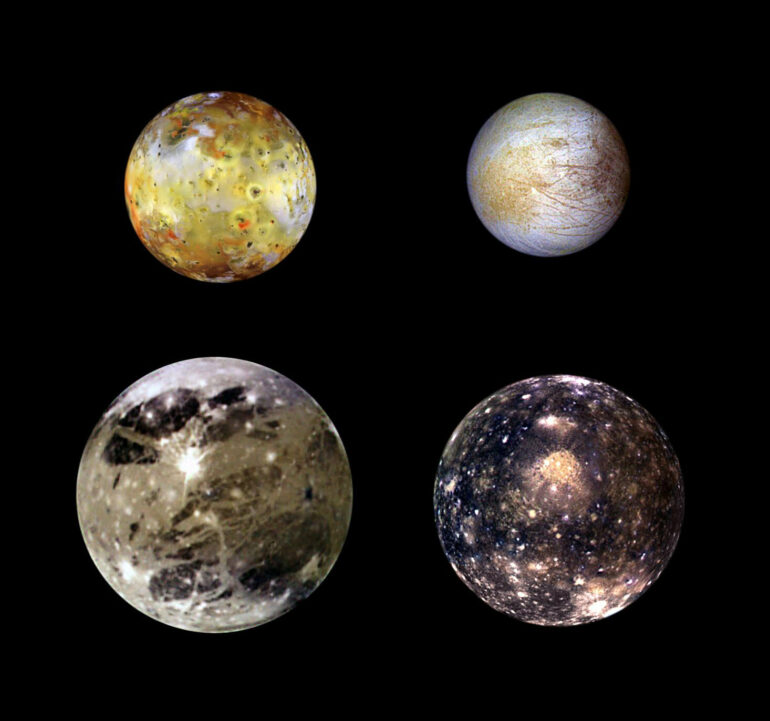Astronomers using W. M. Keck Observatory on Maunakea in Hawaiʻi have discovered that aurorae at visible wavelengths appear on all 4 major moons of Jupiter: Io, Europa, Ganymede, and Callisto.
Using Keck Observatory’s High-Resolution Echelle Spectrometer (HIRES) as well as high-resolution spectrographs at the Large Binocular Telescope and Apache Point Observatory, a team led by Caltech and Boston University observed the moons in Jupiter’s shadow so that their faint aurorae, which are caused by the gas giant’s strong magnetic field, could be spotted without competition from bright sunlight reflected off of their surfaces.
“These observations are tricky because in Jupiter’s shadow the moons are nearly invisible. The light emitted by their faint aurorae is the only confirmation that we’ve even pointed the telescope at the right place,” says Katherine de Kleer, Caltech professor and lead author of one of two new research papers published today in The Planetary Science Journal describing the discovery.
All four of the Galilean moons show the same oxygen aurora we see in skies near the Earth’s poles, but gases on Jupiter’s moons are much thinner, allowing a deep red color to glow nearly 15 times brighter than the familiar green light.
At Europa and Ganymede, oxygen also lights up infrared wavelengths, just a little redder than the human eye can see—the first occurrence of this phenomenon seen in the atmosphere of a body other than Earth.
At Io, Jupiter’s innermost moon, volcanic plumes of gas and dust are vast in size, reaching hundreds of kilometers in height. These plumes contain salts like sodium chloride and potassium chloride, which break down to produce additional colors. Sodium gives Io’s aurora the same yellowy-orange glow that we see in urban streetlamps. The new measurements also show potassium aurora at Io in infrared light, which has not been detected anywhere else previously.
“The brightness of the different colors of aurora tell us what these moons’ atmospheres are likely made up of,” said de Kleer. “We find that molecular oxygen, just like what we breathe here on Earth, is likely the main constituent of the icy moon atmospheres.”
The new measurements show minimal evidence for water, fueling an active scientific debate over whether the atmospheres of Jupiter’s moons feature significant water vapor. It’s currently believed that the outer 3 Galilean moons of Jupiter contain oceans of liquid water beneath their thick icy surfaces, and there’s tentative evidence that water in Europa’s atmosphere may sometimes be sourced from its ocean or liquid reservoirs within its ice shell.
Since Jupiter’s strong magnetic field is tilted, aurorae on these moons change in brightness as the planet rotates. Additionally, the atmospheres can respond to the rapid transition from warm sunlight to the cold shadow of Jupiter.
“Io’s sodium becomes very faint within 15 minutes of entering Jupiter’s shadow, but it takes several hours to recover after it emerges into sunlight,” explains Carl Schmidt, Astronomy Professor at Boston University and lead author of the second paper. “These new characteristics are really insightful for understanding Io’s atmospheric chemistry. It’s neat that eclipses by Jupiter offer a natural experiment to learn how sunlight affects its atmosphere.”
New types of aurora on the four moons add an exciting aspect to what is already a golden age for fans of Jupiter thanks to NASA’s Juno mission and the James Webb Space Telescope. If you’re lucky enough to see the aurora here on Earth, pause to consider how amazing the show might appear if you were looking up from one of Jupiter’s moons.
The first paper about this research, led by de Kleer, is titled “The Optical Aurorae of Europa, Ganymede, and Callisto.” The second paper, led by Schmidt, is titled “Io’s Optical Aurorae in Jupiter’s Shadow.”
More information:
Katherine de Kleer et al, The Optical Aurorae of Europa, Ganymede, and Callisto, The Planetary Science Journal (2023). DOI: 10.3847/PSJ/acb53c
Carl Schmidt et al, Io’s Optical Aurorae in Jupiter’s Shadow, The Planetary Science Journal (2023). DOI: 10.3847/PSJ/ac85b0
Provided by
W. M. Keck Observatory
Citation:
New aurorae detected on Jupiter’s four largest moons (2023, February 16)



